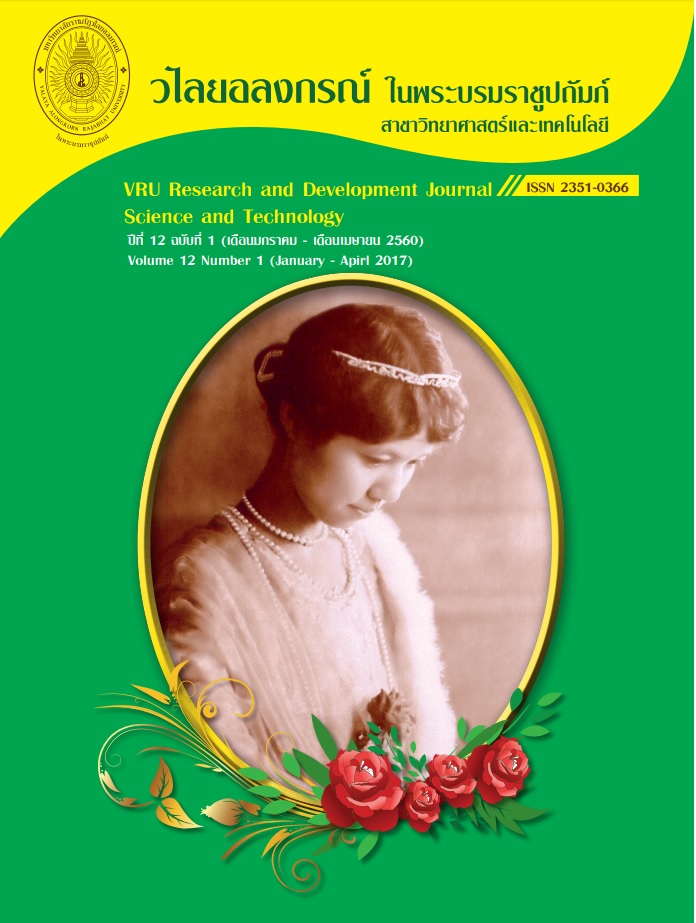สมบัติของไบโอชาร์ที่ผลิตจากเศษข้าวโพด และศักยภาพในการใช้เป็นวัสดุปรับปรุงดิน
Main Article Content
Abstract
วัตถุประสงค์ของการศึกษาครั้งนี้คือการศึกษาสมบัติของไบโอชาร์ที่ผลิตจากเศษข้าวโพด และศักยภาพในการใช้เป็นวัสดุปรับปรุงดิน โบโอชาร์ที่ในการศึกษาได้จากการใช้เตาผลิตแบบแอนิลา โดยใช้เศษข้าวโพดเลี้ยงสัตว์เป็นวัตถุดิบในการผลิต สมบัติของไบโอชาร์ที่ศึกษาได้แก่ สัณฐานของพื้นผิวด้วยการถ่ายภาพด้วยกล้องจุลทรรศน์อิเล็คตรอนแบบส่องกราด ขนาดของช่องว่าง และพื้นที่ผิว ปริมาณธาตุองค์ประกอบด้วยการวิเคราะห์ด้วยเทคนิคการเรืองแสงรังสีเอกซ์ การวิเคราะห์องค์ประกอบสาร และโครงสร้างโครงผลึก ใช้การวิเคราะห์ด้วยเทคนิคการเลี้ยวเบนของรังสีเอ็กซ์ ค่าความเป็นกรดด่าง และค่าการนำไฟฟ้า ปริมาณคาร์บอน, ไนโตรเจน และซัลเฟอร์ ปริมาณ โพแทสเซียม, แคลเซียม, แมกนีเซียม, โซเดียม และฟอสฟอรัส ผลการศึกษาพบว่าไบโอชาร์ มีลักษณะพื้นผิวที่มีความพรุนสูง มีค่าพื้นที่ผิวจำเพาะ 93.36 m2/g มีขนาดช่องว่างเฉลี่ย 30.24 Å เปอร์เซ็นต์ของแร่ออกไซด์ต่อน้ำหนักของไบโอชาร์ ส่วนใหญ่เป็น ซิลิกา ประมาณ 30.4 เปอร์เซ็นต์ ผลการวิเคราะห์สมบัติทางเคมีของไบโอชาร์พบว่ามีความเป็นกรดด่าง 7.76 ค่าความจุในการแลกเปลี่ยนประจุบวก 46.06 cmol/kg จัดว่ามีค่าสูงมาก มีปริมาณโซเดียมทั้งหมด 240 mg/kg ปริมาณโปแทสเซียมทั้งหมด 23,323 mg/kg ปริมาณแมกนีเซียมทั้งหมด 1,407 mg/kg และ ปริมาณแคลเซียมทั้งหมด 990 mg/kg ปริมาณฟอสฟอรัสนำไปใช้ได้ 421.22 mg/kg มีปริมาณคาร์บอนเป็นส่วนประกอบ 52.77 เปอร์เซ็นต์ ปริมาณไนโตรเจน 1.09 เปอร์เซ็นต์ และ ปริมาณซัลเฟอร์ 0.049 เปอร์เซ็นต์ และ มีอัตราส่วนคาร์บอนต่อไนโตรเจน 48.41 จากผลการวิเคราะห์นี้ทำให้ทราบว่าไบโอชาร์มีสมบัติที่เหมาะสมในการใช้เป็นวัสดุปรับปรุงดินทั้งการเพิ่มค่าการดูดซึมน้ำ การแลกเปลี่ยนประจุบวกเพื่อยึดธาตุอาหาร และการเพิ่มธาตุอาหารในดินโดยตรง
The aim of this research was to study the properties of corn waste biochar and potential use as a soil improvement. In this study, biochar was obtained by Anila Stove. Physical properties of biochar studied including, surface morphology by scanning electron microscope(SEM), specific surface area and pore size, elemental contained by X-Ray Fluorescence (XRF), substance element analysis and crystal structure by X-Ray Diffraction (XRD). Chemical properties of biochar studied including pH, Electrical conductivity(EC), cation exchange capacity(CEC), Carbon, Nitrogen, Sulfur, Potassium, Calcium, Magnesium, Sodium, Phosphorus and C/N Ratio. The analysis of the biochar physical properties revealed that height of specific surface area was 93.36 m2/g and pore size about 30.24 Å and contained 30.4% of silica oxide. The analysis of the biochar chemical properties revealed that 7.76 of pH, 46.06 cmol/kg of CEC, 240 mg/kg of Sodium, 23,323 mg/kg of Potassium, 1,407 mg/kg of Magnesium, 990 mg/kg of Calcium, 421.22 mg/kg of available Phosphorus 52.77% of Carbon contained, 1.09% of Nitrogen, 0.049% of Sulfur and 48.41 of C/N ratio. From the experiment, it was convinced that physical and chemical properties of biochar are more suitable for soil amendment due to height of specific surface area and pore which are increase water holding capacity, height of CEC which are increase nutrients holding and adding Sodium, Potassium, Phosphorus to soil directly.
Downloads
Article Details
Copyright Notice
The copyright of research articles published in the VRU Research and Development Journal Science and Technology Journal belongs to the Research and Development Institute, Valaya Alongkorn Rajabhat University under the Royal Patronage. Reproduction of the content, in whole or in part, is prohibited without prior written permission from the university.
Responsibility
The content published in the VRU Research and Development Journal Science and Technology Journal is the sole responsibility of the author(s). The journal does not assume responsibility for errors arising from the printing process.
References
Abel, S., Peters, A., Trinks, S., Schonsky, H., Facklam, M., & Wessolek, G. (2013). Impact of biochar and hydrochar addition on water retention and water repellency of sandy soil. Geoderma, 202, 183-191.
Asai, H., Samson, B. K., Stephan, H. M., Songyikhangsuthor, K., Homma, K., Kiyono, Y., . . . Horie, T. (2009). Biochar amendment techniques for upland rice production in Northern Laos: 1. Soil physical properties, leaf SPAD and grain yield. Field Crops Research, 111(1–2), 81-84.
Borchard, N., Wolf, A., Laabs, V., Aeckersberg, R., Scherer, H. W., Moeller, A., & Amelung, W. (2012). Physical activation of biochar and its meaning for soil fertility and nutrient leaching - a greenhouse experiment. Soil Use and Management, 28(2), 177-184.
Cao, X., & Harris, W. (2010). Properties of dairy-manure-derived biochar pertinent to its potential use in remediation. Bioresource Technology, 101(14), 5222-5228.
Eykelbosh, A. J., Johnson, M. S., de Queiroz, E. S., Dalmagro, H. J., & Couto, E. G. (2014). Biochar from Sugarcane Filtercake Reduces Soil CO2 Emissions Relative to Raw Residue and Improves Water Retention and Nutrient Availability in a Highly-Weathered Tropical Soil. PLoS ONE, 9(6).
Glaser, B., Haumaier, L., Guggenberger, G., & Zech, W. (2001). The 'Terra Preta' phenomenon: a model for sustainable agriculture in the humid tropics. Naturwissenschaften, 88(1), 37-41.
Houben, D., Evrard, L., & Sonnet, P. (2013). Mobility, bioavailability and pH-dependent leaching of cadmium, zinc and lead in a contaminated soil amended with biochar. Chemosphere, 92(11), 1450-1457.
Lehmann, J., Gaunt, J., & Rondon, M. (2006). Bio-char Sequestration in Terrestrial Ecosystems – A Review. Mitigation and Adaptation Strategies for Global Change, 11(2), 395-419.
Li, X. M., Shen, Q. R., Zhang, D. Q., Mei, X. L., Ran, W., Xu, Y. C., & Yu, G. H. (2013). Functional Groups Determine Biochar Properties (pH and EC) as Studied by Two-Dimensional C-13 NMR Correlation Spectroscopy. PLoS ONE, 8(6).
Liang, B., Lehmann, J., Solomon, D., Kinyangi, J., Grossman, J., O'Neill, B., . . . Neves, E. G. (2006). Black Carbon Increases Cation Exchange Capacity in Soils. Soil Sci. Soc. Am. J., 70(5), 1719-1730.
Morales, M. M., Comerford, N., Guerrini, I. A., Falcao, N. P. S., & Reeves, J. B. (2013). Sorption and desorption of phosphate on biochar and biochar-soil mixtures. Soil Use and Management, 29(3), 306-314.
Ohsowski, B. M., Klironomos, J. N., Dunfield, K. E., & Hart, M. M. (2012). The potential of soil amendments for restoring severely disturbed grasslands. Applied Soil Ecology, 60(0), 77-83.
Ulyett, J., Sakrabani, R., Kibblewhite, M., & Hann, M. (2014). Impact of biochar addition on water retention, nitrification and carbon dioxide evolution from two sandy loam soils. European Journal of Soil Science, 65(1), 96-104.
Yao, Y., Gao, B., Chen, H., Jiang, L., Inyang, M., Zimmerman, A. R., . . . Li, H. (2012). Adsorption of sulfamethoxazole on biochar and its impact on reclaimed water irrigation. Journal of Hazardous Materials, 209–210(0), 408-413.
Zhao, X.-r., Li, D., Kong, J., & Lin, Q.-m. (2014). Does Biochar Addition Influence the Change Points of Soil Phosphorus Leaching? Journal of Integrative Agriculture, 13(3), 499-506.


